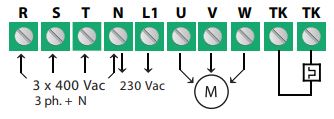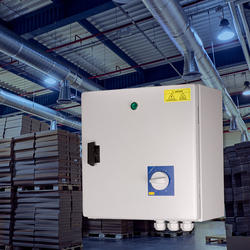EU declaration conformity
400 V transformer fan speed controller | TK monitoring | 4 A
Product description
Transformer fan speed controller for 400 V motors with thermal contacts. The maximum motor current is 4 A.
The fan speed can be adjusted via an integrated rotary switch on the front cover. The TK monitoring function stops the motor in case of overheating.
The fan speed can be adjusted in five steps by reducing the motor voltage. The output voltage is fully sinusoidal and guarantees quiet operation of the motor.
The housing can be surface mounted and has protection class IP54 against ingress of dirt, dust and moisture.
The supply voltage is 400 V.
Documents
Additional specifications and description
General info
The STRS4-40L40 is designed to provide multiple speed options for controlling a 400 V, three-phase fans using an autotransformer, which allows for the adjustment of the voltage supplied to the fan motor, which in turn affects the rotational speed of the motor and thus the fan speed. The autotransformer has multiple taps or terminals along the primary winding, which provide different voltage levels corresponding to various fan speed settings.
The control mechanism is a 5-step rotary switch. When a specific speed setting is selected on the rotary switch, it adjusts the transformer taps, thereby changing the voltage supplied to the fan motor and controlling the fan speed accordingly. Each step or position on the switch corresponds to a specific output voltage, allowing users to choose the desired fan speed. The available output voltages are: 130, 180, 230, 300 and 400 VAC.
Wiring
When wiring a three-phase fan motor, you need to follow specific guidelines to ensure correct connections and safe operation.
The first step is to identify the motor leads. Typically, for three-phase motors there are leads, labeled U, V and W for the three phases. These are the outputs to the motor, while the controller itself is supplied using the R, S and T terminals + N (for neutral).

Check the motor nameplate or specifications to determine the voltage rating of the motor. It is essential to match the motor voltage with the available power supply voltage.
Depending on the motor voltage and the available power supply, you may need to wire the motor in either a delta (Δ) or a wye / star (Y) configuration. The motor nameplate or manufacturer's documentation should indicate the suitable wiring configuration for the specific motor model.
Follow the grounding guidelines specified by local electrical codes. Typically, three-phase motors require grounding for safety purposes.
Mounting
When mounting the fan speed controller on a wall or panel, it is important to follow certain installation instructions and guidelines to ensure proper functionality and safety.
Choose a sturdy and secure mounting surface that can support the weight of the controller. Ensure that the surface is flat and free from any obstructions or protrusions that could interfere with the installation or operation of the controller.
Mount the controller in a vertical position. This allows for proper airflow and cooling of the internal components. Ensure that there is adequate ventilation around the controller. Leave sufficient space around the controller for airflow, especially on the sides and top, to prevent overheating and ensure optimal cooling. Install the controller in a location with a suitable ambient temperature range. Avoid areas that are excessively hot, such as near heat sources or in direct sunlight, as this can negatively affect the performance and lifespan of the controller. Follow instructions for wiring the controller. Ensure that the wiring is properly secured and protected to prevent damage or accidental contact.
Consider any specific environmental conditions that may impact the controller's performance, such as exposure to moisture, dust, or corrosive substances. If necessary, take additional measures to protect the controller, such as using appropriate enclosures or covers. Install the controller in a location that allows for easy access for maintenance, inspection and adjustments, if required. Ensure that there is sufficient space around the controller to access the switches, terminals, and any other user interface elements.
Enclosure
The STRS4-40L40 features a metal enclosure with paint coating resistant to external mechanical impacts. The IP54 ingress protection rating guarantees that the enclosures are designed to provide a high level of protection against dust and water ingress, they are effectively sealed against dust particles and can withstand water splashes from any direction, making them suitable for moderately harsh environments.
The control mechanism is a 5-step rotary switch. When a specific speed setting is selected on the rotary switch, it adjusts the transformer taps, thereby changing the voltage supplied to the fan motor and controlling the fan speed accordingly. Each step or position on the switch corresponds to a specific output voltage, allowing users to choose the desired fan speed. The available output voltages are: 130, 180, 230, 300 and 400 VAC.
Wiring
When wiring a three-phase fan motor, you need to follow specific guidelines to ensure correct connections and safe operation.
The first step is to identify the motor leads. Typically, for three-phase motors there are leads, labeled U, V and W for the three phases. These are the outputs to the motor, while the controller itself is supplied using the R, S and T terminals + N (for neutral).

Check the motor nameplate or specifications to determine the voltage rating of the motor. It is essential to match the motor voltage with the available power supply voltage.
Depending on the motor voltage and the available power supply, you may need to wire the motor in either a delta (Δ) or a wye / star (Y) configuration. The motor nameplate or manufacturer's documentation should indicate the suitable wiring configuration for the specific motor model.
Follow the grounding guidelines specified by local electrical codes. Typically, three-phase motors require grounding for safety purposes.
Mounting

When mounting the fan speed controller on a wall or panel, it is important to follow certain installation instructions and guidelines to ensure proper functionality and safety.
Choose a sturdy and secure mounting surface that can support the weight of the controller. Ensure that the surface is flat and free from any obstructions or protrusions that could interfere with the installation or operation of the controller.
Mount the controller in a vertical position. This allows for proper airflow and cooling of the internal components. Ensure that there is adequate ventilation around the controller. Leave sufficient space around the controller for airflow, especially on the sides and top, to prevent overheating and ensure optimal cooling. Install the controller in a location with a suitable ambient temperature range. Avoid areas that are excessively hot, such as near heat sources or in direct sunlight, as this can negatively affect the performance and lifespan of the controller. Follow instructions for wiring the controller. Ensure that the wiring is properly secured and protected to prevent damage or accidental contact.
Consider any specific environmental conditions that may impact the controller's performance, such as exposure to moisture, dust, or corrosive substances. If necessary, take additional measures to protect the controller, such as using appropriate enclosures or covers. Install the controller in a location that allows for easy access for maintenance, inspection and adjustments, if required. Ensure that there is sufficient space around the controller to access the switches, terminals, and any other user interface elements.
Enclosure
The STRS4-40L40 features a metal enclosure with paint coating resistant to external mechanical impacts. The IP54 ingress protection rating guarantees that the enclosures are designed to provide a high level of protection against dust and water ingress, they are effectively sealed against dust particles and can withstand water splashes from any direction, making them suitable for moderately harsh environments.






.webp)
.webp)
.webp)
.webp)
.webp)

Remarks, reviews & ratings